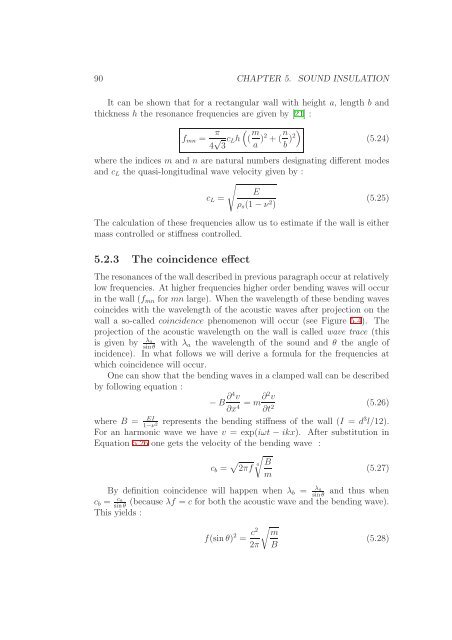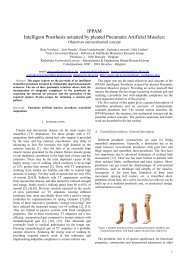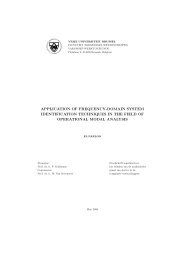VRIJE UNIVERSITEIT BRUSSEL Acoustics - the Dept. of ...
VRIJE UNIVERSITEIT BRUSSEL Acoustics - the Dept. of ...
VRIJE UNIVERSITEIT BRUSSEL Acoustics - the Dept. of ...
Create successful ePaper yourself
Turn your PDF publications into a flip-book with our unique Google optimized e-Paper software.
90 CHAPTER 5. SOUND INSULATIONIt can be shown that for a rectangular wall with height a, length b andthickness h <strong>the</strong> resonance frequencies are given by [21] :f mn = π4 √ 3 c Lh(( m a )2 +( n )b )2(5.24)where <strong>the</strong> indices m and n are natural numbers designating different modesand c L <strong>the</strong> quasi-longitudinal wave velocity given by :√Ec L =(5.25)ρ s (1−ν 2 )The calculation <strong>of</strong> <strong>the</strong>se frequencies allow us to estimate if <strong>the</strong> wall is ei<strong>the</strong>rmass controlled or stiffness controlled.5.2.3 The coincidence effectTheresonances<strong>of</strong><strong>the</strong>walldescribedinpreviousparagraphoccuratrelativelylow frequencies. At higher frequencies higher order bending waves will occurin <strong>the</strong> wall (f mn for mn large). When <strong>the</strong> wavelength <strong>of</strong> <strong>the</strong>se bending wavescoincides with <strong>the</strong> wavelength <strong>of</strong> <strong>the</strong> acoustic waves after projection on <strong>the</strong>wall a so-called coincidence phenomenon will occur (see Figure 5.4). Theprojection <strong>of</strong> <strong>the</strong> acoustic wavelength on <strong>the</strong> wall is called wave trace (thisis given by λasinθ with λ a <strong>the</strong> wavelength <strong>of</strong> <strong>the</strong> sound and θ <strong>the</strong> angle <strong>of</strong>incidence). In what follows we will derive a formula for <strong>the</strong> frequencies atwhich coincidence will occur.One can show that <strong>the</strong> bending waves in a clamped wall can be describedby following equation :−B ∂4 v∂x 4 = m∂2 v∂t 2 (5.26)where B = EI1−ν 2 represents <strong>the</strong> bending stiffness <strong>of</strong> <strong>the</strong> wall (I = d 3 l/12).For an harmonic wave we have v = exp(iωt − ikx). After substitution inEquation 5.26 one gets <strong>the</strong> velocity <strong>of</strong> <strong>the</strong> bending wave :c b = √ 2πf 4 √Bm(5.27)By definition coincidence will happen when λ b = λa and thus whensinθc b = ca (because λf = c for both <strong>the</strong> acoustic wave and <strong>the</strong> bending wave).sinθThis yields :f(sinθ) 2 = c22π√ mB(5.28)
















